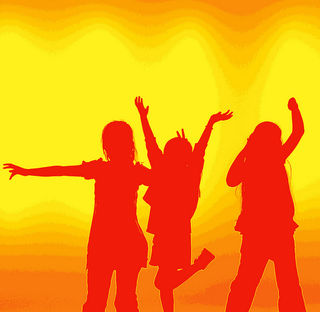
Is your child popular? Does he or she want to be? Do you consider popularity an important goal for kids or teens?
The priority that children place on popularity increases over the elementary school years, peaking in late middle school and early high school. For example, LaFontana and Cillessen found that less than 10 percent of children in grades one through four consider popularity more important than friendship, but over a quarter of fifth through eighth graders—and one-third of ninth through twelfth graders—did. Other research by Gavin and Furman found that early and middle adolescents generally place more emphasis on conforming and being part of a popular group than younger or older children do.
Kids, Cliques, and the Social Hierarchy
By the time children are 11 years old, almost all of them say they are part of a friendship group or clique. Classic research by Patricia and Peter Adler, involving extensive observations and interviews with children in fourth through sixth grade in a white middle class community, identifies a hierarchy of cliques:
- About one third of students are in the dominant popular clique. This group engages in a lot of nasty political maneuvering to maintain or enhance social status.
- Next comes the "wannabe" group, involving one tenth of students. They hang around the edges of the popular group, hoping for acceptance. They get enough crumbs of approval to keep them hooked, but rarely gain full acceptance.
- Middle status cliques include about half of the students. These involve smaller, independent friendship groups, where the emphasis is on being loyal, caring, and supportive of each other. These kids tend to dislike the popular clique kids, because they consider them stuck up, but they also look down on less popular kids.
- At the bottom of the social hierarchy are about one tenth of students. Members of this group don't belong to any clique and are socially isolated. These children are at risk for being targets of bullying.
Who Are the Popular Kids?
Peers tend to describe popular kids as attractive, athletic, wealthy, nice dressers, and “not boring.” Popularity is also linked to being friends with other popular peers. Researchers distinguish between “popular-prosocial children” and “popular-antisocial children.”
The prosocial popular children are “nice” kids who do well in school and act in friendly ways toward their peers. They’re also good at handling conflict in constructive ways, and they very rarely resort to aggressive tactics.
The antisocial popular children are “cool” kids who are socially competent, but not necessarily kind. This group includes “tough boys,” who tend to be good athletes but poor students, behave in defiant ways toward adults, and often get in trouble. It also includes socially manipulative boys and girls who strategically use a combination of kindness and meanness to enhance their own social status. For instance, these children will act in friendly ways toward certain children but ignore, exclude, and spread mean gossip about other children. “Cool” kids tend to be admired and feared by their peers.
There are age differences in how peers respond to antisocial popular kids. The social impact of these children tends to be highest during the middle school years. Research by Antonius Cillessen and his colleagues finds that relational aggression is not associated with popularity among nine- to 11-year-olds, but it is for 12- to 15-year-olds. By the end of middle school or during high school, peers may start to view relationally aggressive kids (especially girls) as stuck up, and they may turn against them. The bigger social world of high school often dilutes the social power of cool kids, because other kids have more options for forming relationships based on a wider variety of interests.
Is Popularity a Good Thing?
It can be a heady feeling to be at the peak of a social group, but there are some downsides to being popular. For instance, Lara Mayeux and her colleagues found that popularity is linked to risky behaviors such as smoking, drinking alcohol, and early sexual activity among high school students. Becoming more popular can also lead to peer resentment and dislike. One study found that only 9 percent of popular children are widely liked by their peers.
Excessive focus on popularity can also involve a distorted perspective on relationships. Jennifer Crocker and her colleagues argue that focusing on self-image goals at the expense of more compassionate goals leads people to feel competitive, anxious, depressed, and disconnected.
Is it Possible to Change Popularity Status?
Kids often wonder what they can do to become more popular. Molly Dawes and Hongling Xie at Temple University found that sixth graders who were high in popularity goals—meaning they strongly endorse the idea that it’s important that others view them as popular—reported using more popularity-driven behaviors, such as dressing, dating, or hanging out with certain people in ways intended to enhance their popularity. They also reported using more physical and social aggression.
But did these tactics work? Comparing popularity status in the fall versus spring semester, Dawes and Xie found that just having a high popularity goal didn’t change popularity status. How that goal was expressed and by whom did matter.
The sixth graders who were initially very popular increased their popularity by acting in more physically and socially aggressive ways. They may have strategically targeted other kids who were generally disliked by peers and less able to retaliate.
On the other hand, when initially low-popularity sixth graders used more aggressive tactics, their popularity did not improve—perhaps because they targeted high-status peers with more social power.
It seems that already-popular kids can get away with bad behavior, and may even enhance their social dominance by doing it strategically, but unpopular kids can’t. However, there's an ethical problem involved in enhancing one's own peer status by hurting others.
Is it Risky for Kids to Try to Become More Popular?
There’s generally no harm in learning about and conforming to some extent with peer culture preferences regarding simple issues like clothing, slang, or musical taste. Kids who don't know about these may set themselves up for unnecessary rejection by nonverbally announcing to their peers, "I'm not like you!" Individuality and uniqueness are great, but relationships begin with perceived similarity. For kids, understanding and following general group norms is no different than adults dressing and acting appropriately at work. However, dressing the part is no guarantee of popularity.
Befriending popular children can enhance popularity, but this is risky because it often involves a loss of previous friends. For instance, if a girl turns away from her old friends to hang out with more elite girls, her old friends may feel hurt or consider her a snob. If she is then treated cruelly by the popular kids, she may end up feeling she has no place to go socially. She may feel stuck or lost, because she no longer likes the popular kids, but she has burned bridges with her old friends.
Implications for Parents: Putting Popularity in Perspective
While it might be tempting for adults to dismiss children’s concerns about popularity, for tweens and teens—who are working on figuring out who they are outside the family—peer status matters. Not all kids can or want to become popular, but all of them need to figure out how they will handle the issue of peer status.
The key role that parents can play involves asking good questions to help children think through how they want to navigate their social world. These can include questions that encourage perspective taking and thinking about values, such as:
- Is she a good friend?
- How do you feel when you're with her?
- How do you think he feels?
- What is the kind thing to do in that situation?
In general, we want to be a voice for authenticity, compassion, and genuine friendship—all of which are more enduring values than popularity.
Related Posts
Is Your Child Inviting Rejection?
Growing Friendships blog posts are for general educational purposes only. They may or may not be relevant for your particular situation. You’re welcome to link to this post, but please don’t reproduce it without written permission from the author.
© Eileen Kennedy-Moore, Ph.D.
References
Adler, P. A., & Adler, P. (1998). Peer power: Preadolescents culture and identity. New Brunswick, NJ: Rutgers University Press.
Cillessen, A. H. N. & Bellmore, A. D. (2004). Social skills and interpersonal perception in early and middle childhood. In P. K. Smith & C. H. Hart (Eds.), Blackwell Handbook of Childhood Social Development (pp. 355-374). Malden, MA: Blackwell.
Cillessen, A. H. N., & Mayeux, L. (2004). From censure to reinforcement: Developmental changes in the association between aggression and social status. Child Development, 75, 147-163.
Cillessen, A. H. N. & Rose, A. J. (2005). Understanding popularity in the peer system. Current Directions in Psychological Science, 14, 102-105.
Crocker, J., Olivier, M., & Nuer, N. (2009). Self-image goals and compassionate goals: costs and benefits. Self and Identity, 8, 251–269.
Dawes, M. & Xie, H. (2013). The role of popularity goal in early adolescents’ behaviors and popularity status. Developmental Psychology.
Gavin L. A. & Furman, W. (1989) Age differences in adolescents’ perceptions of their peer groups. Developmental Psychology, 25, 827-834.
Hawley, (2003). Prosocial and coercive configurations of resource control in early adolescence: A case for the well-adapted Machiavellian. Merrill-Palmer Quarterly, 49, 279-309.
LaFontana, K. & Cillessen, A. H. N. (2010). Developmental changes in the priority of perceived status in childhood and adolescence. Social Development, 19, 130-147.
Merton, D. E. (1997). The meaning of meanness: Popularity, competition, and conflict among junior high school girls. Sociology of Education, 70, 175-191.
Parkhurst, J. T., & Hopmeyer, A. (1998). Sociometric popularity and peer-perceived popularity: Two distinct dimensions of peer status. Journal of Early Adolescence, 18, 125-144.
Rodkin, P. C., Farmer, T. W., Pearl, R., & an Acker, R. (2000). Heterogeneity of popular boys: Antisocial and prosocial configurations. Developmental Psychology, 36, 14-24.




